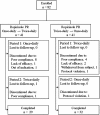Comparison of once-daily versus twice-daily combination of ropinirole prolonged release in Parkinson's disease
- PMID: 24004540
- PMCID: PMC3766261
- DOI: 10.1186/1471-2377-13-113
Comparison of once-daily versus twice-daily combination of ropinirole prolonged release in Parkinson's disease
Abstract
Background: Ropinirole prolonged release (RPR) is a once-daily formulation. However, there may be individual pharmacokinetic differences so that multiple dosing may be preferred in some individuals. This study compares once-daily and twice-daily RPR in patients with Parkinson's disease.
Methods: This study was an open-label crossover study. We enrolled Parkinson's disease patients on dopamine agonist therapy with unsatisfactory control such as motor fluctuation, dyskinesia and sleep-related problems. Agonists were switched into equivalent dose of RPR. Subjects were consecutively enrolled into either once-daily first or twice-daily first groups, and received the same amount of RPR in a single and two divided dosing for 8 weeks respectively in a crossover manner without a washout period.The primary outcome was a questionnaire of the preference completed by patients in the last visit. The secondary outcome measures included the Unified Parkinson's Disease Rating Scale part 3 (mUPDRS), Hoehn and Yahr stage (H&Y); sleep questionnaire including overall quality of sleep, nocturnal off symptoms and early morning symptoms; Epworth Sleep Scale (ESS); compliances and patient global impression (PGI).
Results: A total of 82 patients were enrolled and 61 completed the study. 31 patients preferred twice-daily regimen, 17 preferred the once-daily regimen, and 13 had no preference. Their mean mUPDRS, H&Y, ESS, sleep quality, compliance and adverse events were not statistically different in both regimens. PGI-improvement on wearing off defined was better in twice-daily dosing regimen.
Conclusions: RPR is a once-daily formulation, but multiple dosing was preferred in many patients. Multiple dosing of RPR might be a therapeutic option if once-daily dosing is unsatisfactory.
Trial registration: ClinicalTrials.gov NCT00986245.
Figures
Similar articles
-
Twice-Daily versus Once-Daily Pramipexole Extended Release Dosage Regimens in Parkinson's Disease.Parkinsons Dis. 2017;2017:8518929. doi: 10.1155/2017/8518929. Epub 2017 Feb 7. Parkinsons Dis. 2017. PMID: 28265478 Free PMC article.
-
Efficacy and safety of a once-daily extended-release formulation of pramipexole switched from an immediate-release formulation in patients with advanced Parkinson's disease: results from an open-label study.Drug Res (Stuttg). 2013 Dec;63(12):639-43. doi: 10.1055/s-0033-1351257. Epub 2013 Jul 24. Drug Res (Stuttg). 2013. PMID: 23884661 Clinical Trial.
-
Long-term, open-label, safety study of once-daily ropinirole extended/prolonged release in early and advanced Parkinson's disease.Int J Neurosci. 2016;126(1):30-8. doi: 10.3109/00207454.2014.991924. Epub 2014 Dec 27. Int J Neurosci. 2016. PMID: 25495896 Clinical Trial.
-
Drug safety evaluation of ropinirole prolonged release.Expert Opin Drug Saf. 2014 Mar;13(3):383-9. doi: 10.1517/14740338.2014.870152. Epub 2014 Feb 3. Expert Opin Drug Saf. 2014. PMID: 24490799 Review.
-
Pramipexole extended-release: a review of its use in patients with Parkinson's disease.Drugs. 2014 Dec;74(18):2175-90. doi: 10.1007/s40265-014-0322-5. Drugs. 2014. PMID: 25385556 Review.
Cited by
-
Eryptosis as a marker of Parkinson's disease.Aging (Albany NY). 2014 Oct;6(10):788-819. doi: 10.18632/aging.100695. Aging (Albany NY). 2014. PMID: 25411230 Free PMC article.
-
Nanotechnology-based drug delivery of ropinirole for Parkinson's disease.Drug Deliv. 2017 Nov;24(1):1112-1123. doi: 10.1080/10717544.2017.1359862. Drug Deliv. 2017. PMID: 28782388 Free PMC article.
-
Pharmacological Treatment of Early Motor Manifestations of Parkinson Disease (PD).Neurotherapeutics. 2020 Oct;17(4):1331-1338. doi: 10.1007/s13311-020-00924-4. Epub 2020 Sep 15. Neurotherapeutics. 2020. PMID: 32935299 Free PMC article. Review.
-
Treatment of advanced Parkinson's disease.Curr Opin Neurol. 2014 Aug;27(4):450-60. doi: 10.1097/WCO.0000000000000118. Curr Opin Neurol. 2014. PMID: 24978634 Free PMC article. Review.
-
Twice-Daily versus Once-Daily Pramipexole Extended Release Dosage Regimens in Parkinson's Disease.Parkinsons Dis. 2017;2017:8518929. doi: 10.1155/2017/8518929. Epub 2017 Feb 7. Parkinsons Dis. 2017. PMID: 28265478 Free PMC article.
References
-
- Obeso JA, Rodriguez-Oroz MC, Chana P, Lera G, Rodriguez M, Olanow CW. The evolution and origin of motor complications in Parkinson’s disease. Neurology. 2000;55(11 Suppl 4):S13–S20. discussion S21-13. - PubMed
-
- Stocchi F, Hersh BP, Scott BL, Nausieda PA, Giorgi L, Ease PDMSI. Ropinirole 24-hour prolonged release and ropinirole immediate release in early Parkinson’s disease: a randomized, double-blind, non-inferiority crossover study. Curr Med Res Opin. 2008;24(10):2883–2895. doi: 10.1185/03007990802387130. - DOI - PubMed
Publication types
MeSH terms
Substances
Associated data
LinkOut - more resources
Full Text Sources
Other Literature Sources
Medical




